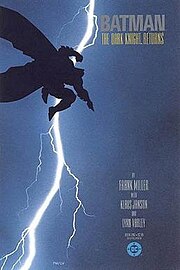
Frank Miller's 1986 limited series Batman: The Dark Knight Returns, which tells the story of a 50-year-old Batman coming out of retirement in a possible future, reinvigorated the character. The Dark Knight Returns was a financial success and has since become one of the medium's most noted touchstones. The series also sparked a major resurgence in the character's popularity.
That year Dennis O'Neil took over as editor of the Batman titles and set the template for the portrayal of Batman following DC's status quo-altering miniseries Crisis on Infinite Earths. O'Neil operated under the assumption that he was hired to revamp the character and as a result tried to instill a different tone in the books than had gone before. One outcome of this new approach was the "Year One" storyline in Batman #404-407 (Feb.-May 1987), in which Frank Miller and artist David Mazzucchelli redefined the character's origins. Writer Alan Moore and artist Brian Bolland continued this dark trend with 1988's 48-page one-shot Batman: The Killing Joke, in which the Joker, attempting to drive Commissioner Gordon insane, cripples Gordon's daughter Barbara, and then kidnaps and tortures the commissioner, physically and psychologically.
The Batman comics garnered major attention in 1988 when DC Comics created a 900 number for readers to call to vote on whether Jason Todd, the second Robin, lived or died. Voters decided in favor of Jason's death by a narrow margin of 28 votes (see Batman: A Death in the Family). The following year saw the release of Tim Burton's Batman feature film, which firmly brought the character back to the public's attention, grossing millions of dollars at the box office, and millions more in merchandising. In the same year, the first issue of Legends of the Dark Knight, the first new solo Batman title in nearly fifty years, sold close to a million copies.
The 1993 "Knightfall" story arc introduced a new villain, Bane, who critically injures Bruce Wayne. Jean-Paul Valley, known as Azrael, is called upon to wear the Batsuit during Wayne's convalescence. Writers Doug Moench, Chuck Dixon, and Alan Grant worked on the Batman titles during "Knightfall", and would also contribute to other Batman crossovers throughout the 1990s. 1998's "Cataclysm" storyline served as the precursor to 1999's "No Man's Land", a year-long storyline that ran through all the Batman-related titles dealing with the effects of an earthquake-ravaged Gotham City. At the conclusion of "No Man's Land", O'Neil stepped down as editor and was replaced by Bob Schreck.
In 2003, writer Jeph Loeb and artist Jim Lee began a "Batman: Hush", a 12-issue run on Batman that introduced a new villain, Hush, guest-starred every major supporting character and Batman villain, and laid the groundwork for the return of Jason Todd. Lee's first regular comic book work in nearly a decade, the series became #1 on the Diamond Comic Distributors sales chart for the first time since Batman #500 (Oct. 1993). Lee then teamed with Frank Miller on All-Star Batman and Robin, which debuted with the best-selling issue in 2005, as well as the highest sales in the industry since 2003. Starting in 2006, the regular writers on Batman and Detective Comics were Grant Morrison and Paul Dini, respectively.










No comments:
Post a Comment